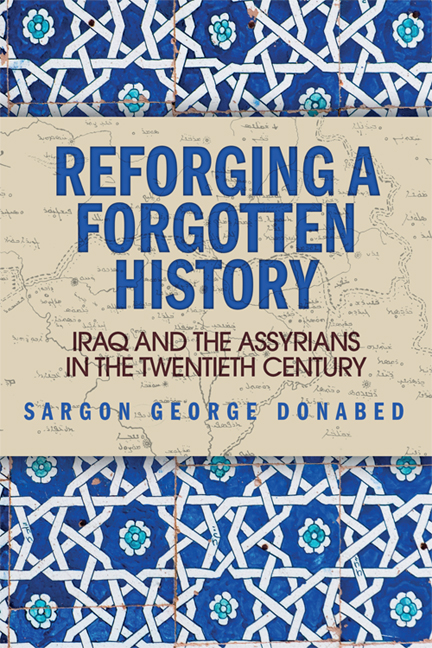Book contents
- Frontmatter
- Contents
- List of Figures
- List of Tables
- Abbreviations
- Acknowledgements
- Dedication
- Map
- Introduction
- 1 Integrating the Assyrian Question
- 2 Framing the Assyrian Narrative: Late Nineteenth and Early Twentieth Century
- 3 Iraq: Building a ‘Nation’-State
- 4 The Birth of the Republic and an Autonomist Struggle
- 5 Enduring Discord: Political Machinations and Border Clearings
- 6 New Movements and War on the Horizon
- 7 State Formation, State-building and Contentious Pluralism
- 8 Conclusion
- Glossary
- Appendix A Village Data
- Appendix B Documents Concerning Cultural and Political Organisations
- Bibliography
- Index
3 - Iraq: Building a ‘Nation’-State
Published online by Cambridge University Press: 05 September 2016
- Frontmatter
- Contents
- List of Figures
- List of Tables
- Abbreviations
- Acknowledgements
- Dedication
- Map
- Introduction
- 1 Integrating the Assyrian Question
- 2 Framing the Assyrian Narrative: Late Nineteenth and Early Twentieth Century
- 3 Iraq: Building a ‘Nation’-State
- 4 The Birth of the Republic and an Autonomist Struggle
- 5 Enduring Discord: Political Machinations and Border Clearings
- 6 New Movements and War on the Horizon
- 7 State Formation, State-building and Contentious Pluralism
- 8 Conclusion
- Glossary
- Appendix A Village Data
- Appendix B Documents Concerning Cultural and Political Organisations
- Bibliography
- Index
Summary
We preferred our own way of living. We were no expense to the government. All we wanted was peace and to be left alone.
Crazy Horse, Oglala Lakota, 1877Between 1914 and 1933 the Middle East transformed rapidly. Nationalism became a new cash crop, a commodity more profitable than oil. Where this created new possibilities and prospects in the region, it also gave birth to tales of broken promises and future despondency. Forced from semi-autonomy into the First World War, the Assyrians watched as their patriarch Mar Benyamin Shimun XXI was murdered by Agha Simko Ismail in 1918 under a flag of parley, only to find themselves alongside the very same Kurds, completely homeless following the war. Soon after the Assyrians in Iraq became detached from their brethren, divided via borders of newly conceived states by the very powers they had endeavoured to aid in the Great War. But it was the events of the late 1920s and early 1930s that would in many ways cement the community's socio-economic, ethnocultural and religious trajectory to the present. According to Yusuf Malek, (then working for the secretary to the administration inspector in Mosul), as early as 1929 circulars from the Iraqi ministries were disseminated throughout the Kurdish regions of northern Iraq, pressing for a massacre of the Assyrians. As the attempt initially gained little support, officials began to play on religious animosities and a more assertive call for a general massacre of Christians was announced. This call appealed to fundamentalist religious convictions, bridging the gap between Kurd and Arab. In this instance, it was the British forces in the streets of Mosul that prevented an immediate massacre.
During the late 1920s, Assyrians had been targeted by central-government manoeuvrings. Seventy-six individuals were marked for political assassination during this time. In 1930, five Assyrians were found murdered near Rawanduz, and more near Mosul, with no criminal investigation into the killings. The machinations of Baghdad were obvious in its attempts to pit the Kurds and Assyrians against each other, while at the same time uniting Iraqis in their hatred of ‘outsiders’ and ‘tools’ of Western occupation. During the same year, relations between Britain and Iraq became closer still with the new Anglo-Iraqi Treaty.
- Type
- Chapter
- Information
- Reforging a Forgotten HistoryIraq and the Assyrians in the Twentieth Century, pp. 93 - 137Publisher: Edinburgh University PressPrint publication year: 2015



